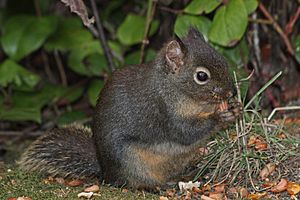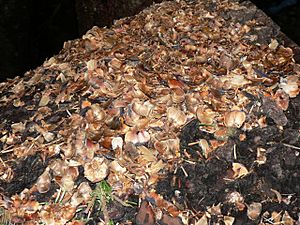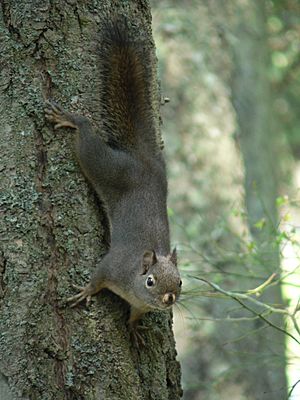Douglas squirrel facts for kids
Quick facts for kids Douglas squirrelTamiasciurus douglasii |
|
|---|---|
 |
|
| Conservation status | |
| Scientific classification | |
| Kingdom: | |
| Phylum: | |
| Class: | |
| Order: | |
| Family: | |
| Genus: | |
| Species: |
T. douglasii
|
| Binomial name | |
| Tamiasciurus douglasii (Bachman, 1839)
|
|
| Subspecies | |
|
|
The Douglas squirrel (Tamiasciurus douglasii) is a small, lively squirrel. It lives in the Pacific Northwest of North America. You can find it in the coastal states of the United States. It also lives along the southwestern coast of British Columbia in Canada.
Sometimes people call it the chickaree or pine squirrel. But these names are also used for the American red squirrel. The Native Americans of Kings River called it the "Pillillooeet". This name sounds like its special alarm call.
Contents
What Does a Douglas Squirrel Look Like?
The famous naturalist John Muir once said the Douglas squirrel was "by far the most interesting" squirrel in California. Adult Douglas squirrels are about 33 centimeters (13 inches) long. This includes their tail, which is about 13 centimeters (5 inches) long. They usually weigh between 150 and 300 grams (5 to 10 ounces).
Their fur changes with the seasons. In summer, their backs are grayish or greenish-brown. Their chest and belly are a pale orange. Their legs and feet look brown. In winter, their coat becomes browner. Their underside turns grayer. Their ears also look fluffier in winter. Like many squirrels, Douglas squirrels have a white ring around their eyes.
Douglas squirrels usually mate as early as February. The mother squirrel is pregnant for about four weeks. The baby squirrels, called kits, are born helpless. They are fed by their mother for about eight weeks. A mother can have up to six kits in one litter. But usually, they have about four. In warmer areas, they might have two litters each year.
Where Do Douglas Squirrels Live?
Douglas squirrels live in coniferous (cone-bearing) forests. These forests are found along the Pacific Coast. Their home range stretches from the Sierra Nevada mountains in California. It goes north to the southwestern coast of British Columbia.
These squirrels prefer old-growth forests. These are very old forests with large trees. They also like mature second-growth forests. Douglas squirrels mostly live where American red squirrels do not. The two types of squirrels rarely live in the same areas.
Douglas squirrels are very territorial. This means they protect their living space. In winter, one squirrel might have a territory of about 10,000 square meters (2.5 acres). During breeding season, a male and female pair will share and defend one territory.
These squirrels are active during the day, all year long. They often chatter loudly at anyone who comes into their territory. In summer, they sleep in ball-shaped nests they build in trees. In winter, they use holes in trees as their cozy nests. If you see a group of squirrels together in summer, they are probably young squirrels from the same family.
What Do Douglas Squirrels Eat?

Douglas squirrels mainly eat seeds from conifer trees. They love seeds from Douglas fir (Pseudotsuga menziesii). They also eat seeds from Sitka spruce (Picea sitchensis) and shore pine (Pinus contorta).
Their diet also includes other foods. They eat acorns, berries, and mushrooms. Sometimes, they eat the eggs of birds, like yellow warblers. They also enjoy some fruits, such as strawberries and plums.
Douglas squirrels are "larder hoarders." This means they store all their food in one special place. This storage spot is called a midden. When a squirrel eats a cone, it peels off the scales to get the seeds. The discarded scales pile up. Over many years, these piles can grow to be several meters (many feet) wide.
Several animals hunt Douglas squirrels. Their predators include American martens, bobcats, domestic cats, northern goshawks, and owls. Douglas squirrels can get used to people being around. But humans can still be a threat to them. This happens if people take their stored cones for tree planting. It also happens when old forests are cut down. However, the number of squirrels does not seem to be affected by commercial thinning of forests.
See also
 In Spanish: Ardilla de Douglas para niños
In Spanish: Ardilla de Douglas para niños



